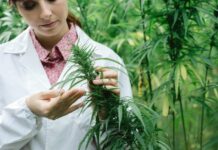Wondering how modern hash can get any better—or more hyped?
Every time it seems like we’ve reached the ultimate pinnacle of achievement in cannabis extracts, something new comes along that gets you even higher.
Kelly Sullivan, lab director, Utopia Cannabis
Right now, at the tip top of the high-end hash market, you’ll find so-called “diamonds”—large lovely crystals of pure THCA, the “acid” form of cannabis’ main active ingredient, THC.
Testing five times as strong as cannabis buds, these THCA diamonds are “dabbed” off of special water-pipes, resulting in soaring euphoria appropriate only for high-tolerance aficionados. It’s a double espresso shot of cannabis for $60 per gram, and a rare delicacy.
Before the Diamond Age
Folks have been making hash for thousands of years in India. But modern industrial agriculture is taking the lead now. Extracts are often made by blasting cannabis buds with a solvent—most commonly butane—to dissolve the plant’s psychoactive resins and oils. The resulting liquid is then purged with low heat and vacuum pressure to reclaim the butane, leaving a pure extract behind.
The largest, most impressive THCA diamonds weigh over one gram, retailing for as much as $120 plus tax. And it’s easy to understand why creating pure THCA crystals just wasn’t possible back in the days when doing so was a felony in California. Near-pure crystals and diamonds of THCA first appeared in California in 2015 from The Guild, the same year state-level medical regulation became law. Since then, modern hash pioneers like The Guild have had to seriously retool for combined medical and adult use regulations, which started taking effect in California in January 2018.
Things have changed a lot, and quickly, according to Santa Cruz, CA’s Utopia Cannabis, which has survived the expensive transition to adult use cannabis. Making solvent hash has gotten a whole lot pricier, but also safer, with increasingly pure and potent products as well.
Looking For Legal Cannabis? Leafly Has All Your Local Menus
Visiting Utopia
 “Fresh-frozen” cannabis makes for more aromatic hash than flower buds that have been dried and cured for weeks. (Elise McDonough for Leafly)
“Fresh-frozen” cannabis makes for more aromatic hash than flower buds that have been dried and cured for weeks. (Elise McDonough for Leafly)
Utopia’s newly licensed extraction facility in Santa Cruz, CA is a spacious warehouse enclosing a warren of offices, laboratories, several trailers of extraction equipment, and a hash vault. Any hash-makers looking to do extraction using volatile solvents including carbon dioxide, butane, hexane, or propane must hold a “Type 7” state and local license. There are 146 licenses currently active in the state, according to the California Department of Public Health.
In one room, a wall of vacuum ovens holds batches of extracts at various stages in their purging process. Workers bustle around in lab coats, wearing nets over their hair, beards included.
Walking through the steps involved in creating Utopia’s live resin and other extracts, extract artist Eden Anaya starts by pulling giant bags of “fresh-frozen” cannabis from a chest freezer. Freezing the plants after harvesting preserves a much larger percentage of the plant’s aroma—its terpenes—and these frozen clumps of grass get broken up and stuffed into “the machine” ten pounds at a time.
 “The Beest” eats 10 pounds of fresh frozen cannabis and spits out cannabis oil for processing. (Elise McDonough for Leafly)
“The Beest” eats 10 pounds of fresh frozen cannabis and spits out cannabis oil for processing. (Elise McDonough for Leafly)
Known as a Bizzy Bee Mega Beest Hex Rack—or simply The Beest—this machine is a conglomeration of silver canisters, hoses, and dials that basically eats weed, uses pressurized gas to digest it, and then spits out a slurry of weed’s best stuff: cannabinoids, terpenes, and flavonoids. It’s a closed-loop process, meaning the gas is separated from the slurry and reused for multiple runs, but the slurry still needs to slowly purge in a vacuum oven until all of the residual solvents evaporate out of the batch. The super-aromatic, potent goop left over is called “live resin”.
The entire production process takes five days before the finished extract is ready to be “grammed out,” separated into tiny portions and packaged in glass jars.
Mining for Diamonds
Creating those highly coveted diamonds takes even longer, involving extra steps to isolate the THCA so it crystallizes. It’s a complex process explained by Utopia’s lab director, Kelly Sullivan, who has a doctorate in biochemistry and specializes in protein crystallization. Routinely used in chemistry as a purification method, crystallization only occurs in a homogenous collection of molecules.
“The whole process of crystallization as purification means only one [type of] molecule can be present,” says Sullivan. “A mix of THC and THCA doesn’t crystallize.”
For THCA, the process of crystallization takes at least two weeks, sometimes a month, but such patience is rewarded. The resulting diamonds—composed of isolated, homogeneous molecules—test at 95 to 98% pure THCA.
 Utopia Cannabis technicians monitor vacuum ovens that purify solvent hash. (Elise Mcdonough for Leafly)
Utopia Cannabis technicians monitor vacuum ovens that purify solvent hash. (Elise Mcdonough for Leafly)
“You’re looking for molecules to begin fitting together like bricks,” Kelly explains, “they’ll start to stack together into things called crystal lattices, and that all starts with a small nucleation, so a few molecules have to nucleate, like a snowball rolling down a hill.”
Afterwards, Utopia adds liquid THC and terpenes (“sauce”) back to the diamonds. This produces better effects, since dabbing pure THCA results in a rather one-dimensional high.
Within the sauce, a viscous mix of THC, terpenes, flavonoids, and other compounds such as plant polyphenols serves to compliment the pure THCA, adding flavor, aroma and modulating the high.
“We call these ‘high terpene full spectrum extracts,’”Anaya says, “because it mimics the compounds found in the real plant, with more robust, real flavor recognizable as coming from that cannabis strain.”
Currently extracting 300 pounds of cannabis every day, Utopia Farms’ live resin is back on dispensary shelves statewide, where it retails for $40 to $60 per gram, more affordable than the diamonds, which retail for $100 per gram.
Working to ramp up production of signature strains including C. Banana, Golden Lemons, and Strawberry Banana, Utopia hopes to bring its diamonds back onto the market this year, much to the joy of high-end connoisseurs.
 (Elise McDonough for Leafly)
(Elise McDonough for Leafly)













